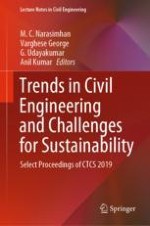This book comprises selected papers from the International Conference on Civil Engineering Trends and Challenges for Sustainability (CTCS) 2019. The book presents latest research in several areas of civil engineering such as construction and structural engineering, geotechnical engineering, environmental engineering and sustainability, and geographical information systems. With a special emphasis on sustainable development, the book covers case studies and addresses key challenges in sustainability. The scope of the contents makes the book useful for students, researchers, and professionals interested in sustainable practices in civil engineering.
